#irish food
Text
The Jewish mark on iconic Irish cuisine:
Corned Beef and Cabbage is a popular dish among Americans on St. Patricks Day. Traditionally, in Ireland, cabbage was and is paired with pork bacon.
However, during the 19th century, as Irish immigrants moved to the U.S., they discovered there was a lower-cost meat alternative to pork. It was their Jewish neighbors who introduced the cured meat and Kosher butchers to the community when they noticed some similarities in the two salty meats. Cooking the corned beef together with cabbage proved to be a low-cost and delicious solution; and the rest is history.

#irish#Irish antisemitism#antisemitism#israel#secular-jew#jewish#judaism#israeli#jerusalem#diaspora#secular jew#secularjew#islam#corned beef and cabbage#corned beef#cabbage#jewish history#lower East side#cuisine#food#Irish food#Irish cuisine#st patricks day#st pattys day
104 notes
·
View notes
Photo
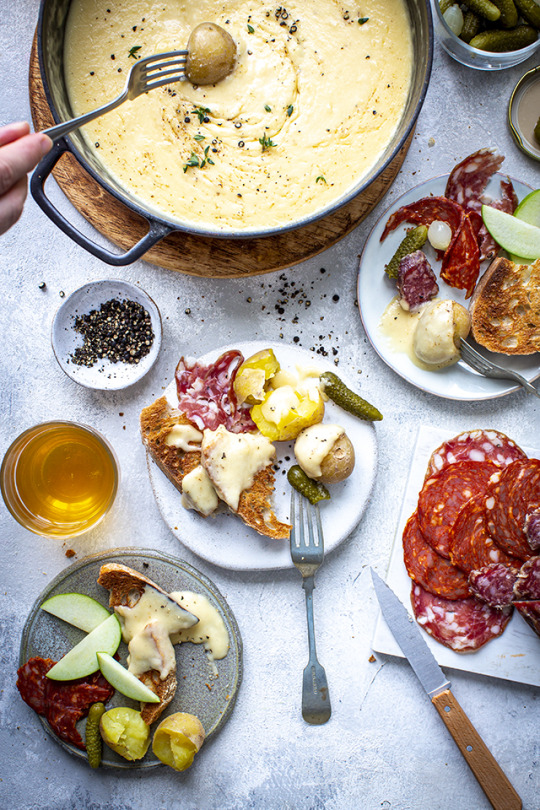
Irish cheese fondue celebration
#cheese fondue#cheese#potatoes#bread#food#salami#charcuterie#potato#melted cheese#dill pickles#dinner#cheesy#irish food#meal#foodporn#delicious#cooking#food photography#foodgasm#recipe
879 notes
·
View notes
Text
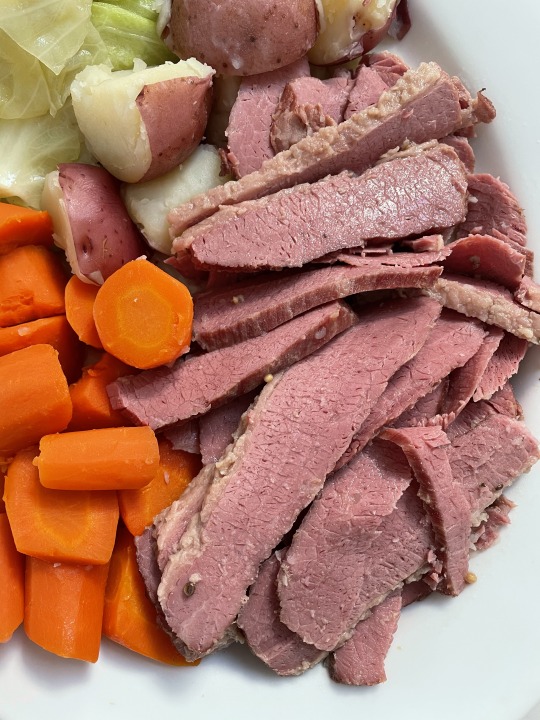
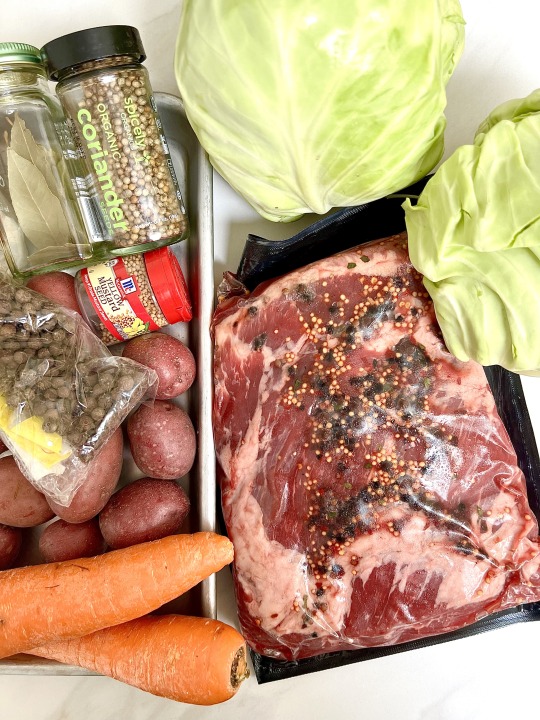

🍀Corned Beef & Cabbage for St. Patrick’s Day!🍀
#corned beef and cabbage#corned beef#beef brisket#st patricks day treats#happy st patricks day#st patricks day#saint patricks day#irish food#cooking#one pot meal#sikfan kitchen#food pics#food#foodies#recipes#food blog
14 notes
·
View notes
Photo

Vegan Irish Soda Bread
122 notes
·
View notes
Text
Sigginstown Pottage
One of the most basic dishes of the medieval period - and in any culture, pretty much - is the pottage. This is basically "stuff cooked in a pot with water", which is a very broad definition. This particular "recipe" is one that I think is straightforward enough, uses common enough ingredients, and is palatable enough that it was almost certainly made in pre-Norman Ireland (by statistical inevitability, if nothing else). I've given it the name of "Sigginstown Pottage" because I first made it at Sigginstown Castle, and it's useful to have a name by which to refer to it.
1 smoked pale ham, chopped into 1cm cubes
2 onions, chopped (or some celery, also chopped)
2 leeks, roughly chopped
6 carrots, roughly chopped
c. 500g pearl barley, bulgur wheat, or other likely whole grain
Water to cover
Put everything above into a pot, and simmer until the meat and grains are cooked. Taste and season with some black pepper if needed. Serve hot.
Some observations: Onion is the more "authentic" between it and celery, but both were available. I've been going easy on onions lately due to food sensitivities. Leeks are absolutely a period Irish food, and possibly close to a staple; they're mentioned a fair bit in texts.
The pale ham (I don't know if this is known outside Ireland; it's a small chunk of cured ham, which is pretty salty) provides enough salt that you shouldn't need to add any more. The smoking is pretty solidly attested in period by the number of bones we see with holes for hooks.
You'll see some people claiming that carrots only arrived in Ireland with the Normans, but there are carrot seeds in the archaeobotanic remnants from Viking Dublin, and there's an old Irish word, meacon, which denotes tap-rooted vegetables like parsnips and carrots, but is usually used for carrots. So I'm pretty confident in including these.
The end result is a very solid, stick-to-the-ribs kind of stew; good eating for colder weather or when you've been doing physical work. I've only ever cooked it in cast iron, and it turns out that if you leave the leftovers in the pot overnight, the combination of whole grains and iron results in a horrifically grey stuff, which still tastes fine, but looks absolutely awful. So eat it hot, and don't leave leftovers.
#pre norman ireland#pre norman irish cuisine#pre norman irish food#irish food#irish medieval food#sca#medieval cooking#medieval food#viking ireland#norse ireland#sigginstown#sigginstown pottage#barley#carrots#leeks#onions#ham#cast iron
41 notes
·
View notes
Text

#food#delicious#tasty#lunch#dinner#stew#pot roast#meat#beef#potatoes#carrots#vegetables#irish food#jack daniels#whiskey#alcohol#shot glasses#rustic
234 notes
·
View notes
Text


St Patrick's Day meal:
Classic corned beef brisket, braised cabbage, sweet potatoes, whipped turnips, mixed veggies and Irish soda bread.
Reuben sandwiches with sauerkraut, Swiss cheese and rye bread the next day!
2 notes
·
View notes
Text
These decadent and succulent lamb chops are perfect for spring!
#foodblogger#therecipetobeornottobe#foodporn#foodie#foodista#foodlover#instafood#foodgasm#food recipes#food porn#foodphotography#easyrecipes#recipes#cookbook#bon appetit#lambchop#artichokes#rosemary#olive oil#garlic#herbs#fresh herbs#orange#chicken broth#mother#irish#irish food#stpatricksday#blog post#blogger
2 notes
·
View notes
Text
Authentic Irish Foods for Bealtaine




🐖 Pig Meats (and blood puddings)
- Irish traditon for pig slaughter states that its only appropriate to slaughter pigs in months which have the letter 'r' (this excludes May, June, July and August; presumably because these warm months would cause spoilage)
- Irish tradition also states that St. Patrick's day is a day which pigs would be slaughtered (presumably in higher numbers than usual) so its safe to assume that Irish peoples would want to finish the meats off around Bealtaine to prevent spoilage
🦌 Deer Meat
🐝🍯 Honey
🐄🥛Cow Dairy products
🐟 River fish (like perch)
🌿Native culinary plants that grow in Ireland this time of year
Dandelions
Wild garlic
Primrose
Nettles
Vetch
Elderflower
Sorrel
Sea lettuce
#irish#irish food#food#Bealtaine#beltaine#beltane#foraging#food cycles#blackcrowing#irish paganism#paganism#irish polytheism#celtic paganism#celtic polytheism#pagan#celtic#irish reconstructionist#irish reconstructionism
17 notes
·
View notes
Text
Cál ceannann (anglicised to ‘colcannon’ )

"Colcannon. Originally and Irish dish of boiled potatoes and cabbage or kale mashed together and flavoured with onion, shallots, or leeks and cream or butter...The word 'colcannon' is from the Gaelic cal ceannann' which literally means white-headed cabbage. However, the cannon' part of the name might be a derivative of the old Irish cainnenn', translated variously as garlic, onion, or leek. Therefore it can be suggested that in its earliest form colcannon may have been a simple mixture of some brassica and allium. One of the earliest Irish references to the dish as a mash of potatoes and cabbages is found in the Diary of Wiliam Bulkely, of Bryndda, near Amlwch in Anglesey, who made two journeys to Dublin in 1735...The dish was introduced into England in the 18th century, where it became a favorite of the upper classes...In Ireland colcannon was associated traditionally with Hallowe'en (31 October) festivities, when it was used for the purposes of marriage divination. Charms hidden in bowls of colcannon were portents of a marriage proposal should unmarried girls be lucky enough to find them, whilst others filled their socks with spoonfuls of colcannon and hung them from the handle of the front door in the belief that the first man through the door would become their future husband."
---Oxford Companion to Food, Alan Davidson [Oxford University Press:Oxford] 1999 (p. 203)
72 notes
·
View notes
Text
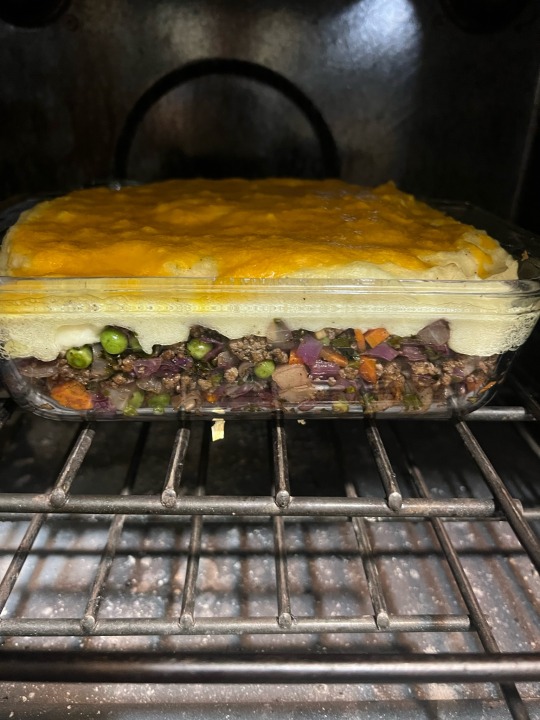
Homemade cottage pie ❤️
3 notes
·
View notes
Text
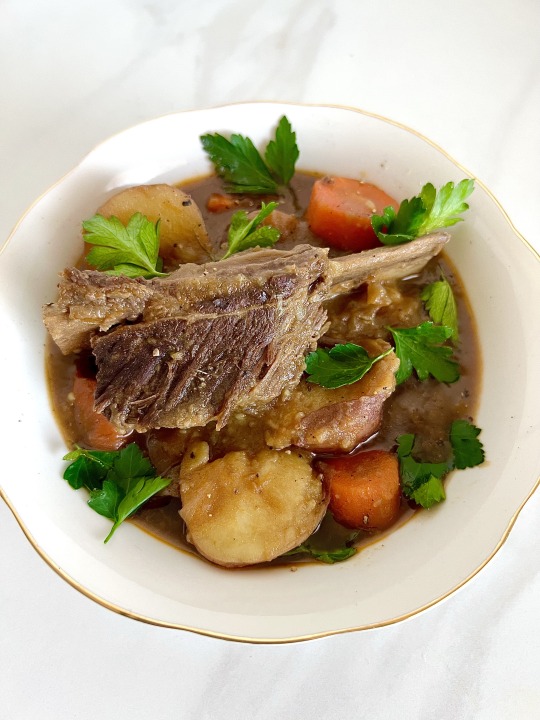
"Irish Short Rib Stew” made with Guinness Beer!!!🍺 Perfect comfort food for St. Patricks Day! ☘️
#irish beef short rib stew#beef stew#irish beef stew#irish stew#stew#guinness beer#irish food#irish recipes#irish cuisine#st patricks day#saint patricks day#food#cooking#foodies#recipes#food blog#homecooking#food pics#sikfan kitchen#st. patrick's day recipe
5 notes
·
View notes
Photo
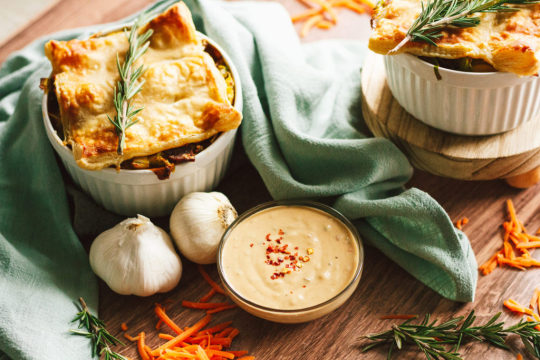
Guinness Stew Pot Pie with a Tahini Chive Sauce
#food#vegan#irish food#stew#pot pie#pies#pastry#vegetables#mushrooms#bacon#comfort food#recipe#alcohol
103 notes
·
View notes
Photo
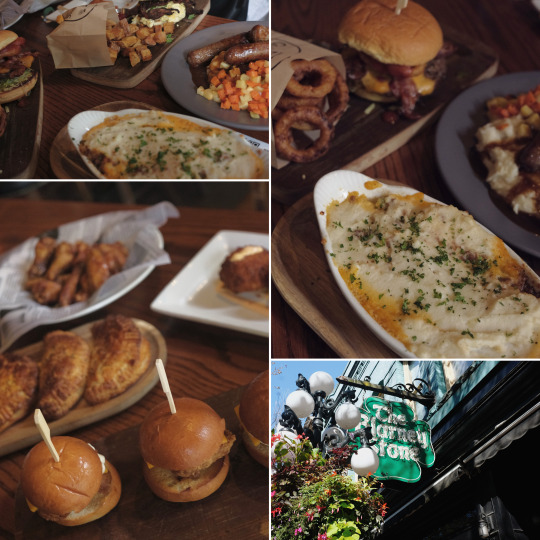
The Blarney Stone Irish Pub x Gastown.
New locally-sourced, overhauled menu from Rosie’s BBQ Executive Chef Karl Gregg.
Breakfast sando: scrambled egg, green onions, bacon, and cheddar on a potato bun.
Bangers and mash: sausages, seasonal roasted root vegetables, mashed potato, Guinness, and onion gravy.
Cottage pie: ground beef, mixed vegetables, buttered mashed potato, and tomato gravy.
“Stone” burger: cheddar, bacon, lettuce, pickles, mayo, BBQ sauce, and onion rings.
Signature Jameson glazed chicken wings.
Irish hand pies: ground beef, peas, mashed potato, and potted beef onion gravy.
Crispy fishwich sliders: hand-battered haddock, tartar, and cheese.
#rick chung#media#features#collage#gastown#gastown vancouver#vancouver#vancity#downtown vancouver#food#foodie#irish pub#irish food#irish#restaurant#bar food#bar#pub#irish bar#bangers#meat#dining#dish#dishes#burger#burgers#sliders#beef#potato#potatoes
3 notes
·
View notes
Text
An Early Irish Feast for Drachenwald's Spring Crown, AS LVIII
Spring Crown this year was hosted by Dun in Mara in the territory of Glen Rathlin. As with almost all SCA projects, this feast didn't quite hit all the things I intended. In particular, I'd been thinking of having documentation available alongside it, and of a few more dishes that didn't make it in the end. A fermented porridge was high on that list. Next time!
Before I start talking about food, though, let me thank my kitchen crew: THL Órlaith Caomhánach, Lady Gabrielle of Dun in Mara, Noble Mallymkun Rauði, Lady Erin Volya and Cassian of Allyshia. There were a few other folk in and out of the kitchen too (THL Yda Van Boulogne did excellent work on the various flavoured butters), but these five did the bulk of the work. Lady Erin also provided lunch; cooking at Crown for 80 people as her first event cookery is notable.
The main idea here was to lean heavily on seafood, which isn't often done in SCA feasts in my experience, and represents the food of Ireland well. I also wanted to include pork as a main meat, emphasise oats and barley, and use plain vegetables presented well. There were to be condiments on the table, hence Yda's butters: plain, honey, mackerel and garlic-and-chive, as well as green sauce (largely Órlaith's work, with Cass finishing it out). Condiments and the number of them available were an important aspect of Irish medieval hospitality.
I also wanted to nod to the usual progress of early Irish feasts, which started with formal services and frequently ended up so raucous and drunken that the nobility woke up the following morning on the hall floor along with everyone else. So we served to the tables to begin, and then had a less and less orderly buffet.
The first "course" was a set of pottages. The main one was pork, cabbage, onion, carrots, turnips, and barley, which had been slowly cooked down over a number of hours. There was also a version with lamb, for those who couldn't eat pork, and this doubled as the gluten-free version, having no barley. And there was a vegetarian one, including barley, but substituting mushrooms for the meat. These were served with flatbreads, risen yeast dough having been a tough proposition in the Irish climate (and still is, really; that's why the most Irish of breads is soda bread).
As that was consumed, we stocked the buffet with: sides of salmon (steamed then baked), mussels (boiled), monkfish and mackerel (also steamed and baked), chicken pieces (baked), hard-boiled eggs, turnips with butter, carrots with honey, samphire (new to many, most enthused about it), caramelised onions, creamed leeks, buttered cabbage with and without bacon bits, and a broth-based porridge, accompanied by a variety of flatbreads and oat pancakes. And as that all cleared, we put out fruit, some cheese, some oaten biscuits, and a "cheesecake", of sorts.
Everything was plausibly pre-Norman Irish, with the exception of the oaten biscuits and the cheesecake base, which were egregiously modern - although I could argue for something very like them. Simple cooking techniques mean that those are broadly plausible as well - steaming may seem incongruous, but I'll have more to say on that again.
It all seemed to go down well. A number of people said they weren't sure about fish, and then followed with "… but that was great!", and the green sauce, the samphire and the cheesecake were particular hits. The technique of doing a wide variety of simple things usually does well, I find; even the pickiest of eaters can usually have a few things, and the adventurous can pile their plates with a wide variety.
And I had energy enough left to wander around the party hall later offering plates of fruit, cheese and biscuits, which is one of my favourite things to do.
#sca#society for creative anachronism#medieval#mediaeval#reenactment#food history#medieval food#irish food#pre-norman irish food#ireland#medievalcore#medieval cooking#drachenwald#drachenwald crown#dun in mara
7 notes
·
View notes
